
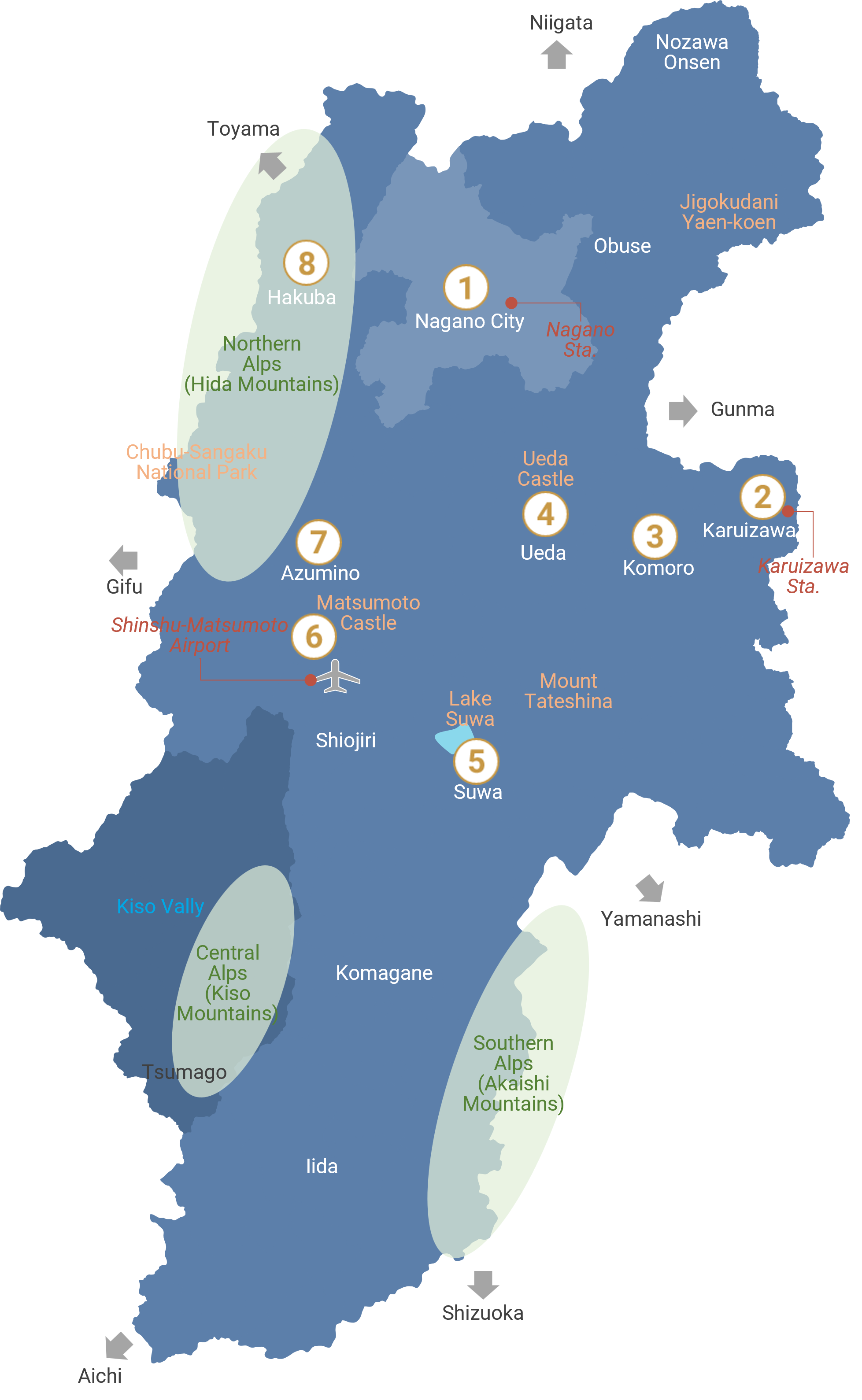
Nagano City served as the central hub of the 1998 Winter Olympics, hosting major events and international visitors. At its heart stands Zenko-ji, one of Japan’s most revered Buddhist temples, attracting pilgrims since the 7th century. With its surrounding mountains and rich cultural legacy, Nagano blends spiritual depth with alpine accessibility
Video by Nagano City, © Nagano City.
Karuizawa is a picturesque mountain resort developed in the Meiji era as a retreat for diplomats, artists, and intellectuals. Its Western-style villas, scenic walking paths, and natural sites like Shiraito Falls continue to charm visitors. With a mild climate and refined atmosphere, it remains a favored destination for seasonal relaxation
Video by Town of Karuizawa, © Town of Karuizawa.
Komoro is known for Komoro Castle, a rare example of a “sunken” castle built below the surrounding town. The castle grounds, now Kaiko-en Park, are famed for seasonal flowers and literary ties to author Toson Shimazaki. The town offers a quiet yet evocative setting, steeped in history and nature
Video by Komoro City, © Komoro City.
Ueda thrived under the Sanada clan, whose castle famously held off Tokugawa forces during the Sengoku era. Today, Ueda Castle Park is a symbol of the city’s resilience and heritage. With surrounding hot springs and historic streets, Ueda retains a proud samurai identity amid tranquil scenery
Video by Ueda City Tourism Association, © Ueda City Tourism Association.
Suwa rests beside Lake Suwa and is anchored by Suwa Taisha, one of Japan’s oldest and most significant Shinto shrines. The city is known for its dynamic Onbashira Festival and long-standing onsen culture. Its lakeside views and spiritual traditions offer a vivid glimpse into local life and belief
Video by Suwa City, © Suwa City.
Matsumoto is famed for Matsumoto Castle, a National Treasure known for its black exterior and original wooden keep. It is also the birthplace of artist Yayoi Kusama and home to a major classical music festival. With its cultural depth and alpine setting, Matsumoto offers a distinctly elegant charm
Video by Matsumoto Tourism and Convention Association, © Matsumoto Tourism and Convention Association.
Azumino lies between the Japan Alps and the Matsumoto Basin, known for its crystal-clear rivers and vast wasabi farms. The landscape is dotted with art galleries, cycling paths, and mountain vistas. Azumino reflects a harmonious blend of rural life, craftsmanship, and serene natural beauty
Video by Azumino Tourist Association, © Azumino Tourist Association.
Hakuba gained global recognition as a major site of the 1998 Winter Olympics and remains one of Japan’s top mountain resorts. With over 200 ski runs and stunning alpine trails, it attracts adventurers year-round. The village is a gateway to the Northern Alps, where sport and scenery meet
Video by Hakuba Village, © Hakuba Village.
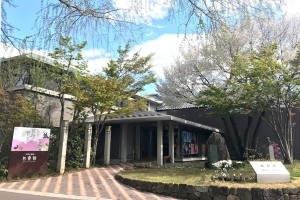
Located in the picturesque town of Obuse, the Hokusai Museum honors ukiyo-e master Katsushika Hokusai’s late works. The collection includes original sketches, prints, and ceiling paintings he created during his final years. It offers a rare, intimate glimpse into the artist’s evolving genius
Photo by Hokusai-kan, © Hokusai-kan.
Zenkoji Temple is one of Japan’s oldest and most important Buddhist temples, founded in the 7th century. It enshrines the first Buddhist statue ever brought to Japan and remains a site of pilgrimage. The temple’s solemn halls and lantern-lit paths evoke deep spiritual reverence
Video by Zenkoji, © Zenkoji.
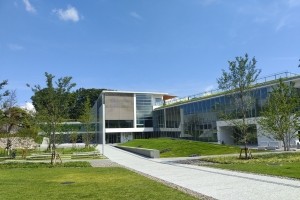
Located beside Zenkoji Temple, this modern museum showcases works by artists connected to Nagano, including Higashiyama Kaii. With its minimalist design and seasonal garden views, the space invites quiet reflection. It serves as a cultural anchor in Nagano’s historical heart
View on Google Maps | Brochure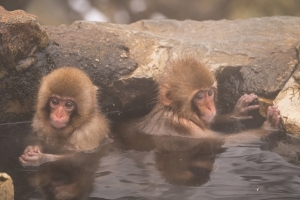
This park is world-famous for its wild Japanese macaques who bathe in natural hot springs during winter. Set in a snow-covered ravine, the scene offers a rare and charming glimpse of animals in relaxation. It’s a unique wildlife encounter found only in Nagano
View on Google Maps
Set against a backdrop of mountains, this open-air mall features high-end outlets, cafes, and scenic walking paths. Its spacious layout and curated mix of brands make it a top shopping destination in the region. The plaza blends leisure, style, and seasonal beauty
View on Google Maps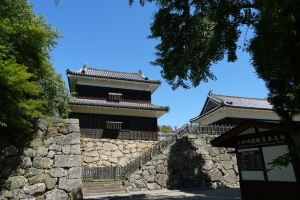
Ueda Castle is known for its strategic brilliance under the Sanada clan, who twice repelled Tokugawa armies. Though only parts of the structure remain, its stone walls and gates evoke strong historical memory. The grounds are a popular site for cherry blossoms and local pride
View on Google Maps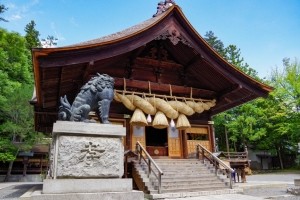
Suwa Taisha is one of Japan’s oldest Shinto shrines, composed of four distinct shrines spread across Lake Suwa’s northern and southern shores. The Upper Shrine in Chino and Lower Shrine in Shimosuwa form a unique “two sites, four shrines” complex. Revered for its ancient rituals, it is also the spiritual center of the Onbashira Festival, held once every seven years
View on Google MapsBuilt in the late 1500s, Matsumoto Castle is a designated National Treasure and one of Japan’s few original surviving castle keeps. Its black-lacquered walls, steep wooden stairs, and defensive moats evoke the tension of the feudal era. Surrounded by open sky and mountain ridges, it anchors the historic heart of Matsumoto
Video by Matsumoto Castle, © Matsumoto Castle.
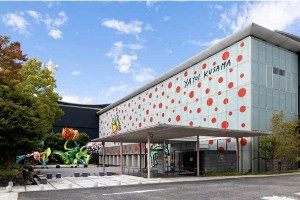
This museum is closely tied to Yayoi Kusama, exhibiting her vivid, polka-dot-themed works alongside other local artists. Its contemporary design contrasts with the city’s historic core. The museum reflects Matsumoto’s unique blend of tradition and avant-garde creativity
Photo by Matsumoto City Museum of Art, © Matsumoto City Museum of Art.
Narai-juku is a beautifully preserved post town on the old Nakasendo trail that once linked Kyoto and Edo. Lined with wooden inns and merchant houses, it transports visitors to the Edo period. Its atmospheric streets are a living heritage of Japan’s travel culture
Video by Shiojiri City Tourist Association, © Shiojiri City Tourist Association.
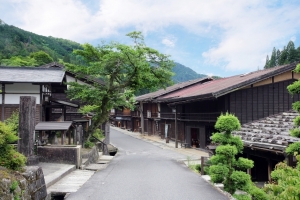
Tsumago-juku is one of the best-preserved Edo-era post towns in the Kiso Valley, complete with cobbled streets and lantern-lit inns. It bans visible power lines and modern signage to maintain historical authenticity. Visitors can walk the old Nakasendo trail between Tsumago and Magome
View on Google MapsNozawa Onsen is a historic hot spring village with over a thousand years of bathing culture and a lively ski resort in winter. Its narrow streets, public bathhouses, and fire festival create a uniquely traditional atmosphere. The town blends alpine adventure with timeless Japanese hospitality
Video by Goolight Co., Ltd, © Goolight Co., Ltd.
Nozawa Onsen is a historic hot spring village with over a thousand years of bathing culture and a lively ski resort in winter. Its narrow streets, public bathhouses, and fire festival create a uniquely traditional atmosphere. The town blends alpine adventure with timeless Japanese hospitality
Video by Venus-Line, © Venus-Line.
Lake Suwa lies at the center of Suwa City and is ringed by hot springs, shrines, and scenic walking paths. In winter, natural ice ridges called omiwatari are said to be footprints of the gods. The lake reflects both folklore and local everyday life
Video by Suwa City, © Suwa City.

As one of Japan’s largest wasabi farms, Daio Wasabi Farm offers views of emerald streams and neatly cultivated fields. Visitors can explore the watermill paths and try freshly grated wasabi. It’s a rare chance to see—and taste—a famed Japanese ingredient at its source
View on Google MapsThis expansive park protects the dramatic peaks of the Northern Alps, including Mount Hotaka and Kamikochi Valley. Known for pristine rivers, alpine flora, and rugged trails, it draws hikers and photographers alike. The park offers some of Japan’s most iconic mountain scenery
Video by Ministry of the Environment, © Ministry of the Environment.
The Kiso Valley is a forested region that once served as a key travel route between Kyoto and Edo. Its post towns, cedar-lined paths, and dramatic gorges preserve a strong sense of old Japan. Today, it invites slow travel and cultural immersion
Video by Kiso Tourist Federation, © Kiso Tourist Federation.
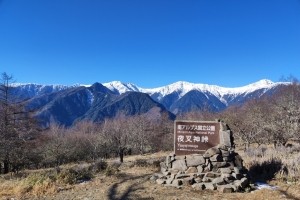
This mountainous park spans rugged peaks over 3,000 meters and deep, untouched valleys. It is known for its biodiversity and remains one of Japan’s more remote alpine reserves. The park is a haven for experienced climbers and nature purists
View on Google MapsHappo-One is one of Japan’s premier ski resorts, offering long runs, Olympic-level terrain, and sweeping alpine views. Located in Hakuba Village, it hosted events during the 1998 Winter Olympics. Its elevation and powder snow attract both casual skiers and seasoned athletes
Video by Hakuba Happo-one Snow Resort, © Hakuba Happo-one Snow Resort.
While many countries preserve diverse regional cuisines, Japan also offers its unique culinary journey. This video highlights select dishes, showcasing distinct local specialties and historical influences in the region
Video by Ministry of Agriculture, Forestry and Fisheries, © Ministry of Agriculture, Forestry and Fisheries.
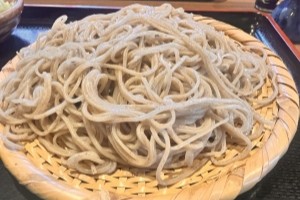
Shinshu Soba is a signature dish of Nagano, made with locally grown buckwheat cultivated in the region’s cool mountain climate. Its nutty aroma and smooth texture are best enjoyed freshly prepared, often with wasabi and dipping sauce. Soba making is a celebrated tradition, reflecting both craftsmanship and seasonal sensibility

Oyaki are rustic dumplings made from fermented buckwheat or wheat dough and stuffed with seasonal vegetables, beans, or pickles. Steamed or grilled, they have long been a staple of Nagano’s countryside diet. Simple yet satisfying, oyaki embodies the resourceful spirit of Shinshu’s mountain culture

JR CENTRAL, a division of the Japan Railways Group, primarily serves the Chubu region, including major routes such as the Tokaido Shinkansen connecting Tokyo, Nagoya, and Osaka. Its smart card, TOICA, enables seamless travel and cashless payments within its network. However, it's region-specific and cannot be used for inter-JR region travel, except for special Shinkansen deals via Express Reservations

JR CENTRAL offers various ticket deals catering to different travel needs in eastern Japan. Find your best from the above link
In the heart of Japan’s Chubu Region, Nagano Prefecture is shaped by the towering Northern, Central, and Southern Alps. Known globally as the host of the 1998 Winter Olympics, it blends alpine beauty with deep cultural roots. Its capital, Nagano City, is home to Zenkoji Temple, one of Japan’s most important pilgrimage sites. The prefecture also features Suwa Taisha and historic post towns along the Nakasendo, an Edo-period route linking Kyoto and Tokyo. With hot springs, traditional architecture, and year-round adventure, Nagano offers a rich mix of nature, faith, and history.
Video by Nagano Prefecture & Nagano Tourism Organization, © Nagano Prefecture & Nagano Tourism Organization.